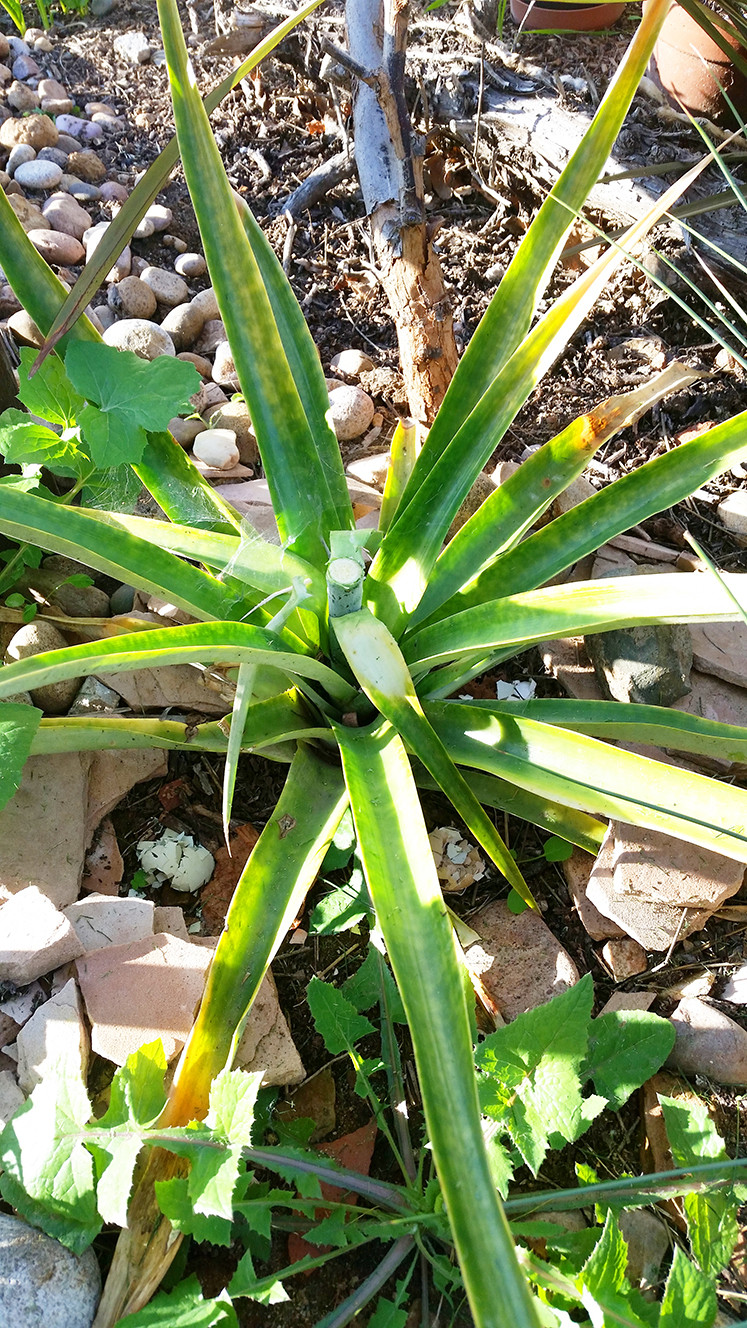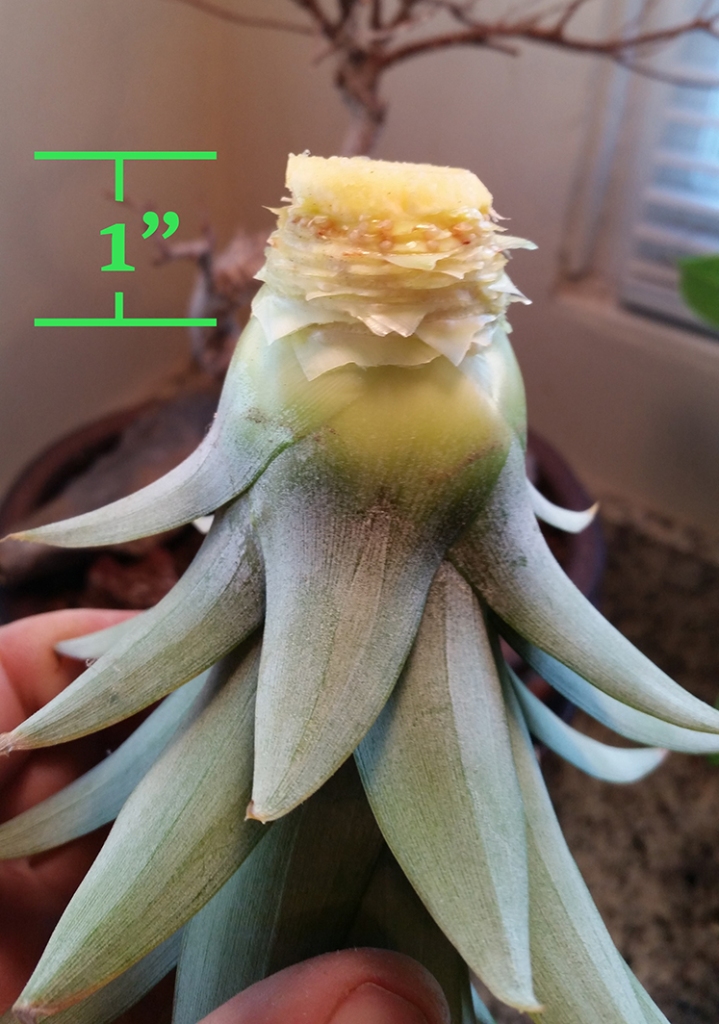As promised, I’m going to share the results of my feeble pineapple efforts. I ordered the small plant online as an add on to my Ficus Religiousa, or Bodi Tree (which was really hard to find by the way). The shipping was free to add it on, so I figured why not. I am fortunate to be living in a zone 10, so I can grow these babies as they only grow in zone 10 to zone 11 outdoors. You can grow them indoors, but they’ll be small so don’t get too disappointed and don’t invite friends over for the “big harvest”. I potted mine in a 4″ pot and gave it what love I could muster in hopes of one day eating my own homegrown pineapple.
Well, that was almost four years ago! In all fairness, I only put it in the ground two years ago. But, oh man, that took forever! Then, about six months ago, I noticed a tiny little pineapple growing out of the center of it. After so long, I had given up so I rarely checked it for any blooms. Then, this is what I saw…

I’ve since discovered that you can force blooms on pineapple plants by introducing calcium carbide to the plant. This however will cause stress on young, small or unhealthy plants, which mine was (and is) so it was probably for the best that I didn’t know this at the time. But, if you’re in a hurry and want results, just go into your junior chemistry kit and grab some calcium carbide! You don’t have a junior chemistry kit? Well, why the hell not? Fear not, there is a much easier way to do this. Apples when ripe release ethylene gasses which will also force a bloom on a pineapple. You can simply cut a slice of apple and place it in the center of the plant for a few weeks. This works best when covered with some clear plastic, like a bag of sorts. I imagine you could simply make a little tent out of clear plastic wrap in a pinch. Anything that will work by trapping the gasses and not blocking the light. Get experimental and let me know your results.
Part I: The harvest
As for my old fashioned method of growing, once the fruit bloomed, it was just a waiting game of a few months to get it to ripen. Now, my plant was small so the fruit was also small. Here we are about five months in with a ripe and ready to pick pineapple…
You can tell it’s ripe in a number of ways. It slowly begins turning yellow from the base up, the small segments of the rind begin to flatten, the fruit will give slightly when squeezed, and most importantly, it will smell ripe. If there is no pineapple scent to it, it’s not ready yet. If it has a vinegar smell to it, it’s beginning to ferment and is overly ripe! If you pick it too soon it’ll stop ripening so be forewarned! In my case it took over three and a half years, so I wasn’t taking any chances! When I was certain it was ripe, with the help of some of my blogging friends; CHOP!


I held it aloft with pride for all the world to see. “look world, look what I hath wrought!” Now get away, cuz there’s not enough to share! I don’t care how puny it is, I was so proud to finally get something out of that plant. After showing the world (who was not paying attention), it was time to slice and serve.


Holy sweet juiciness! Best pineapple I ever had (he said from his psychosomatic soapbox). It took all my strength to not eat it all and save some for my girlfriend (who better eat it fast…). It was, mostly, worth the wait. I haven’t a clue as to how pineapples aren’t $50 each at the grocery store. They take so long and take up so much space per fruit to grow.
Now, I set aside the crown of the pineapple to create a second plant and thusly double my yield. Here’s where the propagation portion comes in.
Part II: How to propagate a pineapple
Once you’ve finished “butchering” your fruit, your face has that sweet pineapple glaze all over it and your belly is doing the happy dance, it’s time to turn that discarded crown into a new plant. The first step is to remove all of the top of the fruit from the base of the crown to avoid any rotting that will occur if you leave it.
Get it nice and clean like the photo above for best results. If you peel off a few of those brown leaves, you should be able to see the makings of new root nodes already! They look like this…

Those cute little pineapple nipples will become the roots for your new plant! Yeah, I said pineapple nipples. Sorry, I’m in a goofy mood. We want to expose a wee bit more of the stalk to ensure a strong rooted base for our new plant so remove about an inches worth of leaves. They kinda spiral around the stalk so work in that fashion.

From here, you can either put it in some good well draining potting soil or root the crown in a cup of water. I like to see the roots develop so I’ll be using the water method. Be certain to change the water every few days to avoid rotting the crown.


I’ll place this in a bright window away from direct sunlight. Once the roots are coming in nicely, I’ll transplant this to a small pot and let it grow for a few months before placing it in a place of prominence in my garden. Come on by in another four years for some fruit salad!







Congratulations! Epic gardening and what a sweet reward.
Thanks Daphne!
Cutest little pineapple I ever did see. (and hopefully will taste…) Would one be able to propagate a pineapple from, say, the farmers’ market?
Excellent question! Many of the pineapples you buy from the grocery store are indeed hybrids and will not propagate from seed. However, using the crown of the fruit is a different strategy. Your actually creating a clone of the parent plant as opposed to the offspring. So, to answer your question, yes you can use this method for any store bought pineapple. Take that Monsanto! And yes, you can have some if you hurry. Only have a few more days for freshness… Tick tock.
Thank you, mad scientist sir—this process is fascinating. Perhaps the next pineapple you clone could be videoed for your curious audience…
Maybe if someone could video me in action this would be possible. As it stands, I don’t have a tripod for my cell phone… Besides, I think more people want to see my plants over my ugly mug. However, message received 😉
Congrats James, looked damn good and juicy.
Reminded me of an old saying.
” Feed a man some pineapple and he will be full for a day.
Teach a man to plant a pineapple and he will have a small snack in about 4 years, and possibly starve while waiting.”
I am going to go buy a pineapple now.
Hahaha! Word. Don’t make me laugh and spit out a bite! Each bite is like 3 months lost!!
Ah, that ancient saying.
Oh one more thing, you wrote about zone 10 and 11. Is there a website or book you use that tells you what zone your in and
gives you a list of plants you can grow? I would like to read about it.
Why yes! The United States Department of Agriculture provides such a map. You can find it here
http://planthardiness.ars.usda.gov/PHZMWeb/
And, now for the low low price of free, check out an old classic from the timeless Old Farmers Almanac which talks about different plants for different hardiness zones…
http://m.almanac.com/plants/hardiness-zone
For more exotic plants, the interwebs can provide their desired zones. You can also create microclimates with some creative landscaping. Or indoors by controlling light, temperature, and humidity.
How have I gone this long with out the Old Farmers Almanac? What a great site.
Well, in your defense, the Old Farmers Almanac has only been around since 1792. It’s hard to keep current with all these fancy schmancy new publications.
Thanks for sharing!
A great report, I will one day try and grow one, it does look quite easy to do. At the moment too busy with Turmeric and Ginger. The other day I bought a turnip at the market and I cut half of it off to use in a soup. The other half I left on the worktop, by now it is a well thriving plant looking very healthy, what fun!
Excellent! I love these types of experiments. Please share photos of your turnip! Cheers Agnes.
Will do so James 🙂
Are you sure you didn’t mistakenly end up with a miniature pineapple plant? Happened to me once with eggplants. LOL! They say Einstien didn’t begin to speak until he was almost a kindergartener..
I’m fairly certain. I think it’s because I put it in a not very optimal location. We’ll see once I plant the new one. It’ll be a race!
lol…shouldn’t have made fun of your first pineapple, it was a tasty little runt after all
My skin is thicker than that pineapple. Poke away! Cheers.
I realized I needed a starting for your molding of the deer.
Come again?
I have tried a few plants, but here in West GA they die in the winter. Any suggestions?
A couple things you can try. The most successful one would be to grow it in a large pot that can be moved into the garage or basement during the winter months. The root system is fairly wide and shallow so they would do well in a pot. Albeit the fruit size would be smaller.
Another option would be to try growing in a raised bed and cover the base of the plant in winter to try to avoid the permafrost altogether.
A makeshift greenhouse might help as well. Something you can remove in the warmer weather.
I imagine your winters aren’t that harsh or long compared to the winters of my youth in Buffalo NY.